15 Fun Historical Attractions in Hong Kong
Visit 15 fun tourist attractions in Hong Kong and learn about history at the same time. Discover ancient Chinese traditions and links to the past that bring the history books to life and uncover and experience the history of Hong Kong and gain a greater understanding of the city. If you’re looking for unique things to do in Hong Kong, this post outlines some fun ways to enjoy the historical side of the city and islands.
Hong Kong is a mixture of new and old. Modern skyscrapers dominate the skyline but the historical landmarks of Hong Kong are not far away. Heritage buildings that are evidence of Hong Kong’s colonial history are easy to find. And in the laneways, there are temples and markets that reveal Hong Kong’s rich and colourful Chinese heritage and culture.
The beautiful islands of Hong Kong lie off the coast of Southeast China and there are many historical places to visit in Hong Kong that you’re sure to enjoy.
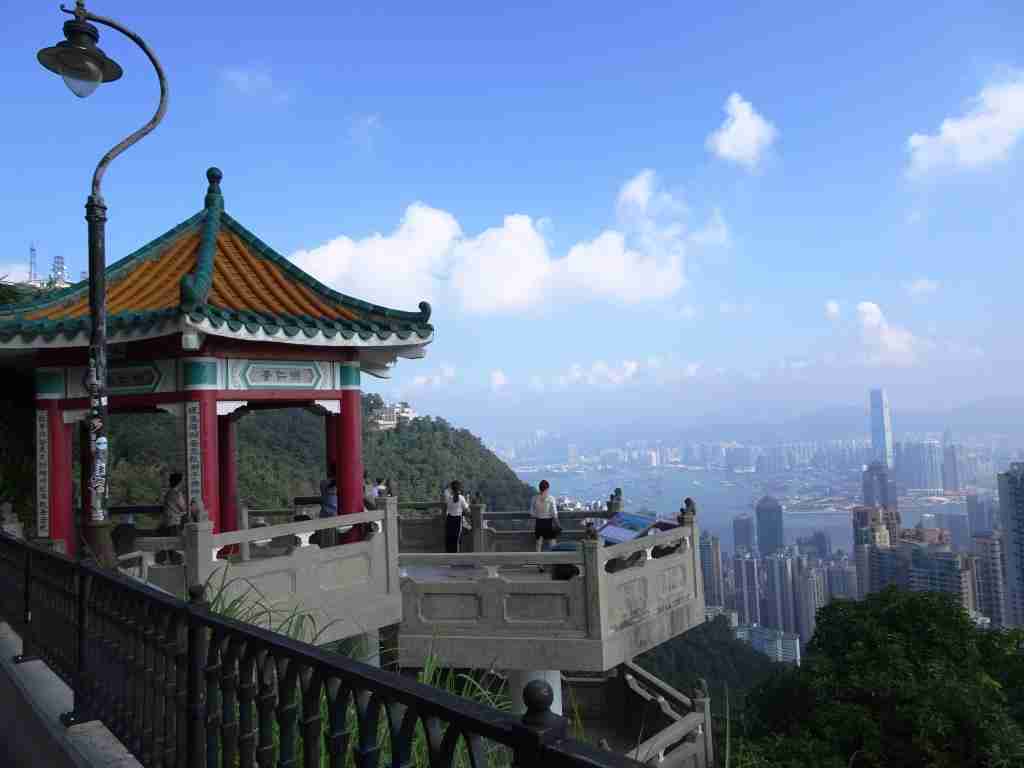
**Check with your local government for the latest information on travel to Hong Kong.
Some of the links on this page are affiliate links which means I may make a small commission on sales that result from clicks on those links. This does not cost you any extra and helps to keep this website running. Thank you for your support!
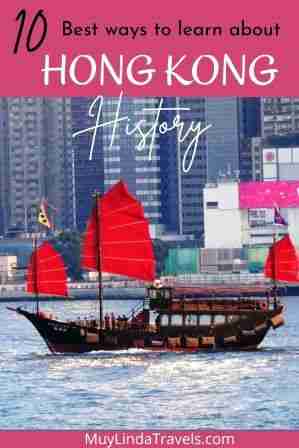
What attracts tourists to Hong Kong
Hong Kong is famous as an international financial centre and is a popular tourist destination. Visitors love the vibrant culture, colonial charm and stunning scenery and Hong Kong also has a top-notch food scene and a busy nightlife. In 2023, Hong Kong is expected to be the most visited city in the world.
Hong Kong Highlights Video
Here are some highlights and attractions in Hong Kong…
Timeline of Hong Kong’s History
- In 1557 the Portuguese settled in Macau, across the water from Hong Kong. This was the first European settlement in Asia and an important trading post for the beautiful silks and porcelain of China.
- At this time the islands of Hong Kong were sparsely populated with small fishing villages.
- In the mid-1800s, during the First Opium War, the British occupied the islands of Hong Kong.
- In 1841, China surrendered Hong Kong to the British and in 1842 the Nanking Treaty was signed to end the First Opium War. Trade in opium and other goods from Asia was lucrative and the British colony of Hong Kong became a commercial centre in Asia.
- In 1898 China leased Hong Kong to the British for 99 years. The ongoing growth of trade through the port in Victoria Harbour leads to the development and growth of the city.
- From 1941 – 1945, during the Second World War, the British were unable to defend Hong Kong and the islands were occupied by the Japanese for almost 4 years.
- In the 1970s China opened up to foreign trade and introduced strict regulations. Hong Kong’s focus changed to financial services.
- In 1997 Hong Kong was returned to the Chinese after 156 years as a British colony.
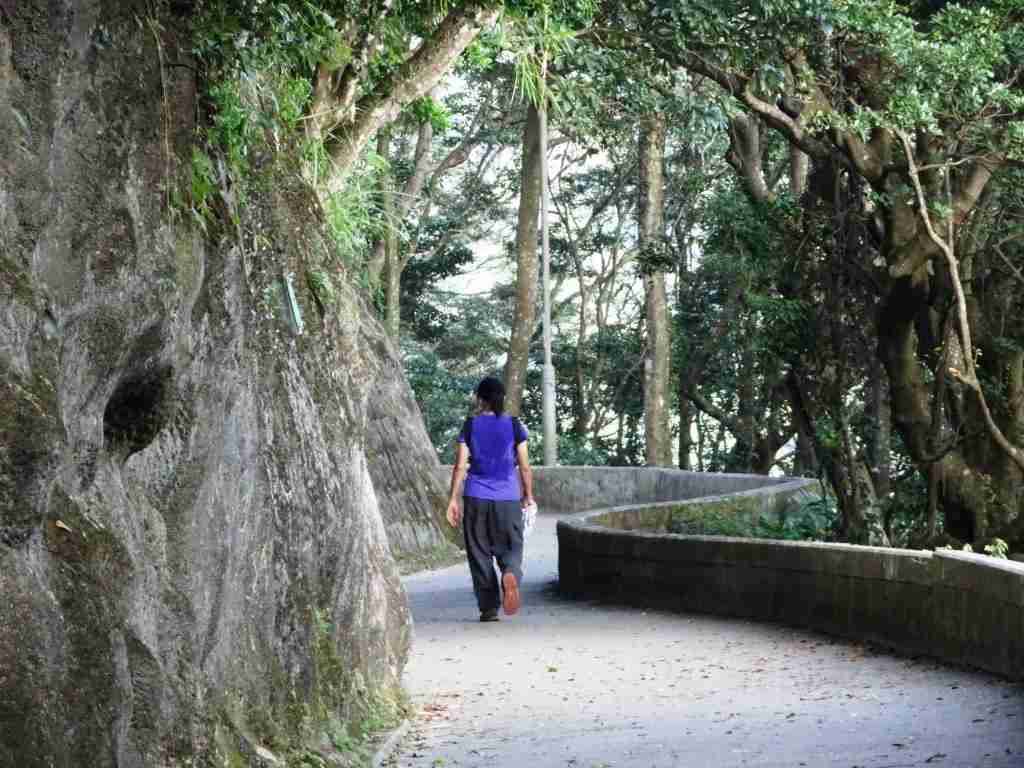
Is Hong Kong part of China?
Hong Kong is officially controlled by China. However Hong Kong is a Special Administrative Region that operates independently from China. This means that Hong Kong has a degree of autonomy with independent laws and judicial powers.
15 Fun Attractions in Hong Kong for History Lovers
There are some wonderful historical places to visit in Hong Kong and here are 10 that you’re sure to enjoy.
The Hong Kong Museum of History
What better place to learn about Hong Kong’s history and culture than the Museum of History? You can see photographs of early Hong Kong at The “History Through the Lens” exhibition and The” Hong Kong Story” exhibit gives a good overview beginning in pre-historic times. People have lived on the islands of Hong Kong since the Stone Age and the exhibit covers the historical development and folk culture in Hong Kong.
The Hong Kong Museum of History opens at 10:00 a.m. and is closed on Tuesdays.
How to get there
Catch the Star Ferry across Victoria Harbour to Tsim Sha Tsui and the museum is located in Kowloon on Chatham Road South next to the Hong Kong Science Museum.
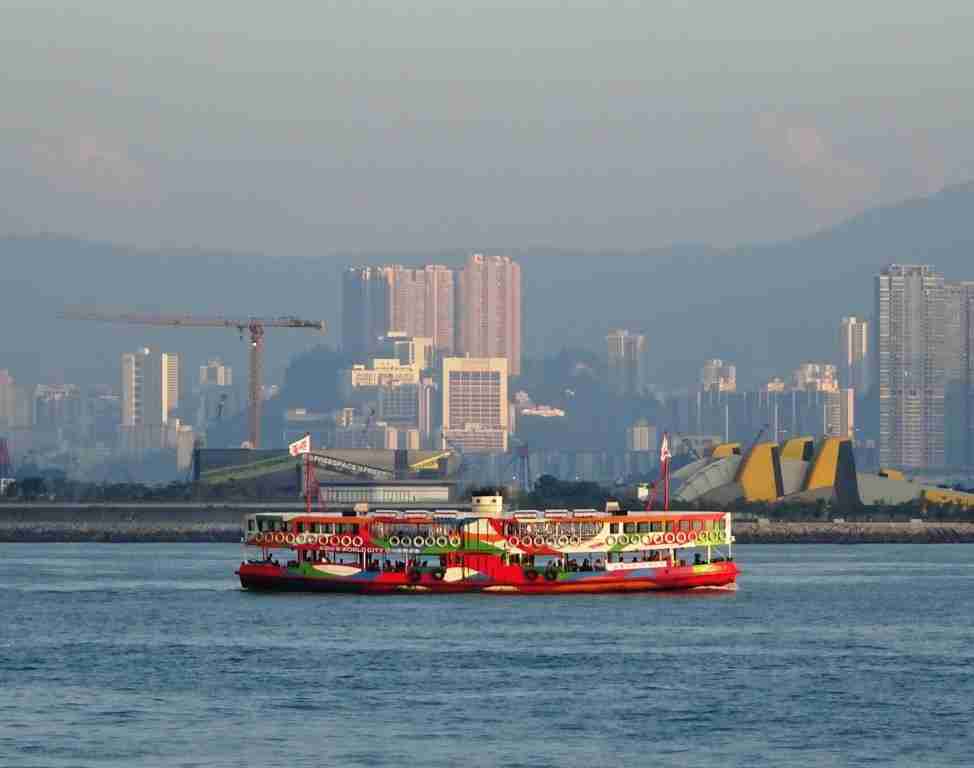
The Star Ferry
The iconic star ferry began taking people across Victoria Harbour in 1880. It was known as the Kowloon Ferry and played an important part in the history of Hong Kong.
The crossing to Kowloon takes about 10 minutes. Riding the Star Ferry is one of the best things to do in Hong Kong and it’s a scenic way to see the famous Victoria Harbour. From the Kowloon side, you’ll get a spectacular view of the skyscrapers and high-rise buildings on Hong Kong Island. Riding on the Star Ferry is one of the cheapest Harbour cruises you can find in one of the most scenic in the world.
The Star Ferry leaves from Central Pier 7 every 5 – 10 minutes from 6:30 am – to 11:30 pm. The Hong Kong Hop-on-Hop-Off Red Route Sightseeing Tour stops here.
Victoria Harbour
The famous Victoria Harbour separates Hong Kong Island from Kowloon and is famous for its busy port that brought trade and prosperity to colonial Hong Kong. The harbour is deep enough to accommodate large containerships and huge cruise ships.
Victoria Harbour was given its name in honour of the English Queen Victoria. Hong Kong is named after the sweet-smelling incense that was transported from Victoria Harbour. The name Hong Kong means “fragrant harbour”.
To enjoy Victoria Harbour catch a ferry from Hong Kong Central Pier, stroll along the harbourside walkways, and watch the FREE “Symphony of Lights” show that lights up Victoria Harbour every evening at 8:00 PM (HKT).
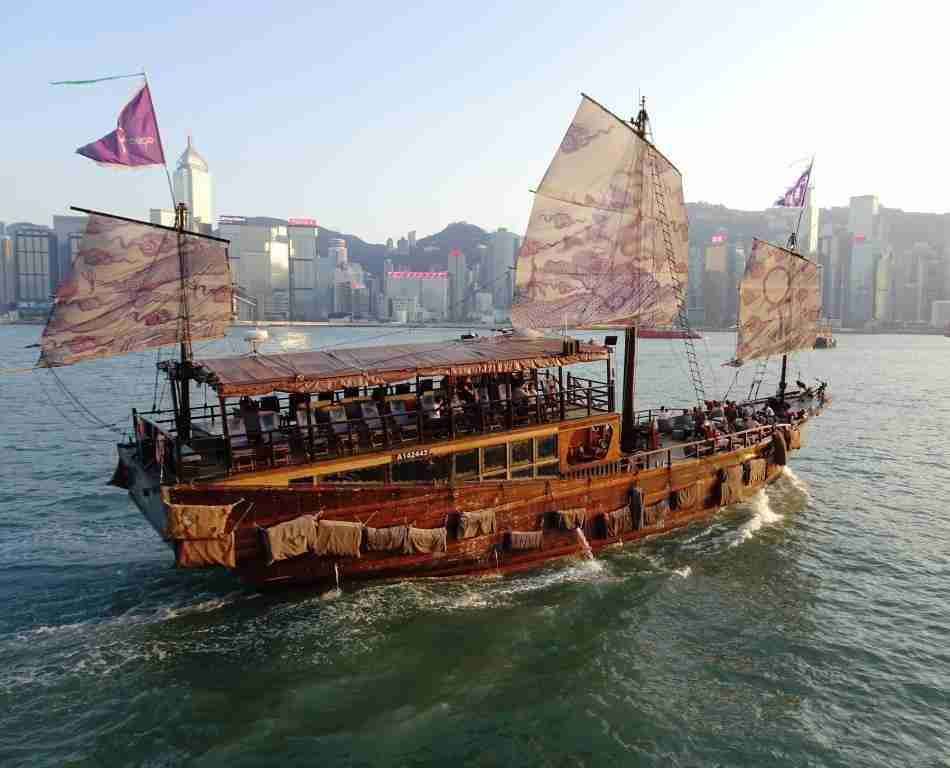
Sail in a Traditional Chinese Junk Boat
Experience history in Hong Kong as you cruise on Victoria Harbour in a traditional Chinese junk boat. Once full of Chinese junks and fishing boats, Victoria Harbour is now a modern port but there are a few traditional Chinese junk boats still on the water. Their brightly coloured sails and wooden decks are a remnant of Hong Kong’s history and you can watch them sail past from vantage points along the harbour shores in Kowloon and Hong Kong Island.
The junk boats are unique attractions in Hong Kong and are especially beautiful at night when their sails are lit up. These restored vessels sail the harbour with passengers on board taking a cruise is a great way to experience history in Hong Kong.
Ride the Hong Kong Trams
Get a feel for Hong Kong’s colonial history as you travel through the city on the narrow double-decker trams. You’ll discover that comfort was not so important in the early 1900s as you bump around on the hard wooden seats. Old narrow-gauge trams operate from Kennedy Town to Shau Kai Wan and Happy Valley on Hong Kong Island.
On the early trams, conductors would collect the fares but these days you can pay your fare with an Octopus Card. Top up your octopus card as you go and use it on all public transport in Hong Kong.
The Peak Tram
The Peak Tram is one of the top attractions in Hong Kong and you can relive Hong Kong’s colonial history riding one of the world’s oldest and most famous funicular tramways. It operates on a cable system on the steep slope of Mount Austen and is one of the most popular tram rides in Hong Kong.
The Peak Tram service began operating in 1888 and is the most direct way to travel to Victoria Peak for tourists and residents. There are spectacular views on the way up the mountain.
TIP: You can enjoy the view from the Peak Tower complex but if you don’t want to pay to see the view, it’s a short walk to the Lions Pavillion where you can enjoy an almost identical view for free.
Victoria Peak
Victoria Peak is a residential area at the top of Mount Austen with a famous lookout point that’s one of the most popular landmarks of Hong Kong. And the historic Peak Tram will take you to the lookout point at Victoria Peak to see the classic view over Hong Kong City and the islands.
But it’s also fun to discover the colonial history of Hong Kong in the lovely parks and walking trails on The Peak. Victoria Peak Garden was once the site of the Governor’s summer residence and it’s now a lovely English garden with Victorian pagodas and winding pathways. To get there from the visitor’s centre, follow Mount Austen Road to Victoria Peak Garden and from there keep following the path to the Lugard lookout and enjoy sweeping views over the other side of Hong Kong Island.
The Peak Tram leaves from Garden Road in Admiralty. You can catch public transport to get there or the Hong Kong Hop-on-Hop-Off Red Route Sightseeing Tour will drop you at the station.

The Man Mo temple
One of the oldest and most famous attractions in Hong Kong, the Man Mo Temple is a small and unassuming building located in Sheung Wan, a short walk from Hong Kong Central. Visiting the sacred Man Mo Temple is a fascinating glimpse into the ancient Taoist religion of Hong Kong and China.
At the Temple you’ll see people lighting incense, bowing and praying at the altar. The small building is full of lanterns and red incense coils hanging from the ceiling and the air is heavy with smoke from the burning sandalwood incense.
The Man Mo Temple was built in the 1800s during the Qing Dynasty and is dedicated to the Gods of Literature and War. During colonial times the Temple was used as a place of worship but it was also used as a courthouse to settle local disputes. And the ritual oaths that were taken at the temple often included the beheading of a rooster.
Next door to the temple the Ancestral Hall is a place where local people pay their respects to their dead ancestors and perform the rituals of ancestor worship. The Man Mo Temple is one of the best historical places to visit in Hong Kong.
**Menstruating women are asked not to enter the main hall and cameras are not allowed in the Ancestral Hall of the Man Mo Temple.
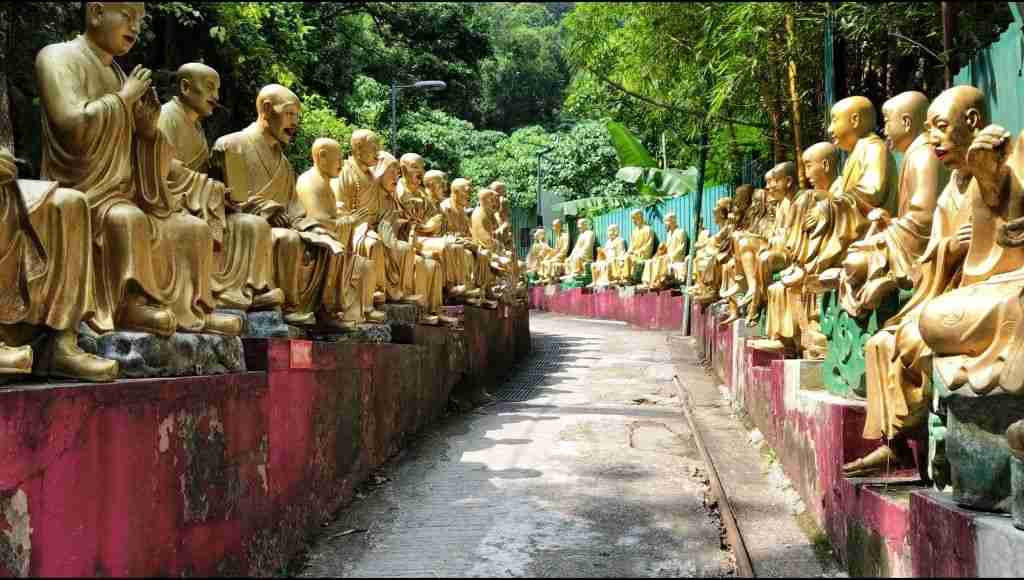
The Ten Thousand Buddhas Monastery
The Ten Thousand Buddha’s Monastery, or Man Fat Tsz, is one of Hong Kong’s historic Buddhist Temples. It’s a remarkable place to visit near Pai Tau village in the New Territories and was one of my favourite things to do in Hong Kong. A steep path leads to the monastery at the top of Po Fook Hill. There are 431 steps and it takes around 20 minutes to climb to the top.
Lining the steep staircase are thousands of golden Buddha statues. Each of the statues is unique. There are young Buddhas, old Buddhas, and monks in meditation, praying and doing everyday activities. The goddess Kwun Yam is also among the statues. She is the goddess of mercy and represents the feminine qualities of compassion and gentleness.
The Ten Thousand Buddhas Monastery was built in 1965 and was funded by the local people of Hong Kong. No monks are living at the monastery but it is a centre of worship for the local community. There are several temples, and in the main hall, the embalmed body of Yuet Kai is exhibited. He was the much-revered monk who built the monastery.
The Ten Thousand Buddhas Monastery is a bit off the beaten tourist path and is located in Sha Tin in the New Territories. But the monastery is unique and very special to visit so it’s well worth the effort to get there and it’s one of the more beautiful historical places to visit in Hong Kong.
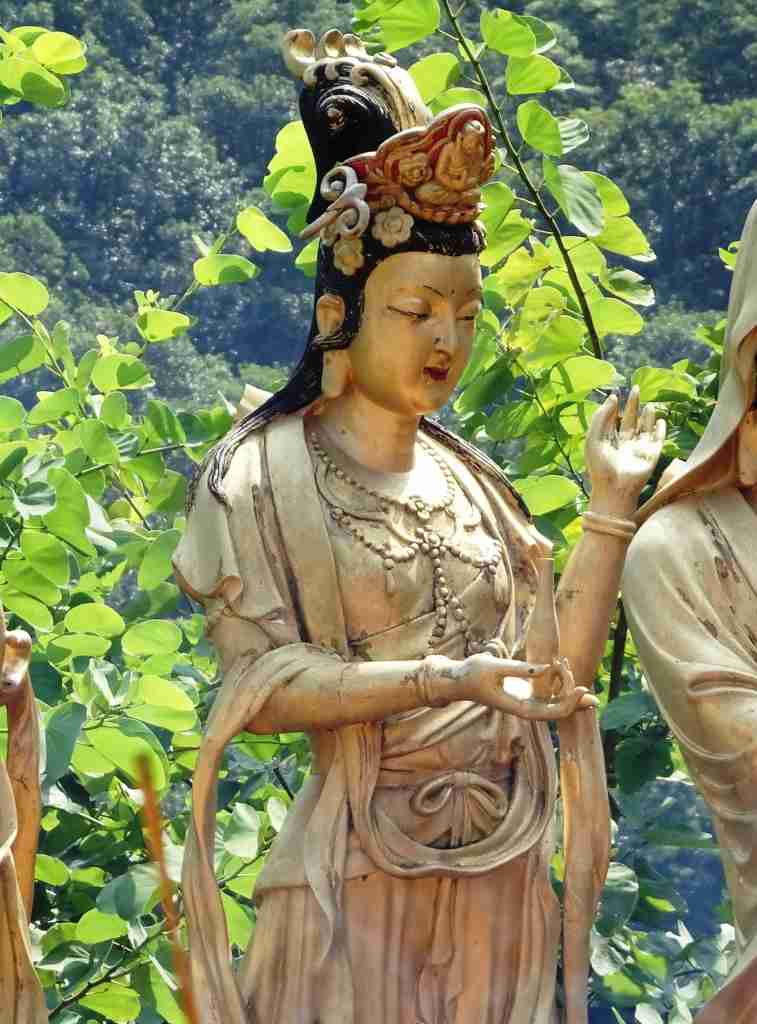

How to get there
Sha Tin is around 16 kilometres from Hong Kong Central. It takes about 30 minutes to get there by train and it’s a 10-minute walk from Sha Tin MTR and bus station. At Sha Tin station take metro exit B and walk to Pai Tau Street. Don’t be distracted by the Pai Tau Ancestral Hall. Walk to the end of Pai Tau Street and the pathway to the monastery is off to the left. It’s unmarked and hard to find. I used my Google Maps app and still need to ask for directions from a local.
The Monastery of the Ten Thousand Buddhas is open from 9 – 5:30 daily.
The Hong Kong Heritage Museum
Also in Sha Tin, is the Hong Kong Heritage Museum, another great place to learn about history in Hong Kong. The museum presents a mix of history, art and culture and is an entertaining and educational experience for visitors.
The Hong Kong Heritage Museum is located beside the Shing Mun River, and not far from the Ten Thousand Buddhas Monastery. You can catch the MTR or take a bus to get there.
**The Heritage Museum is closed on Tuesdays.
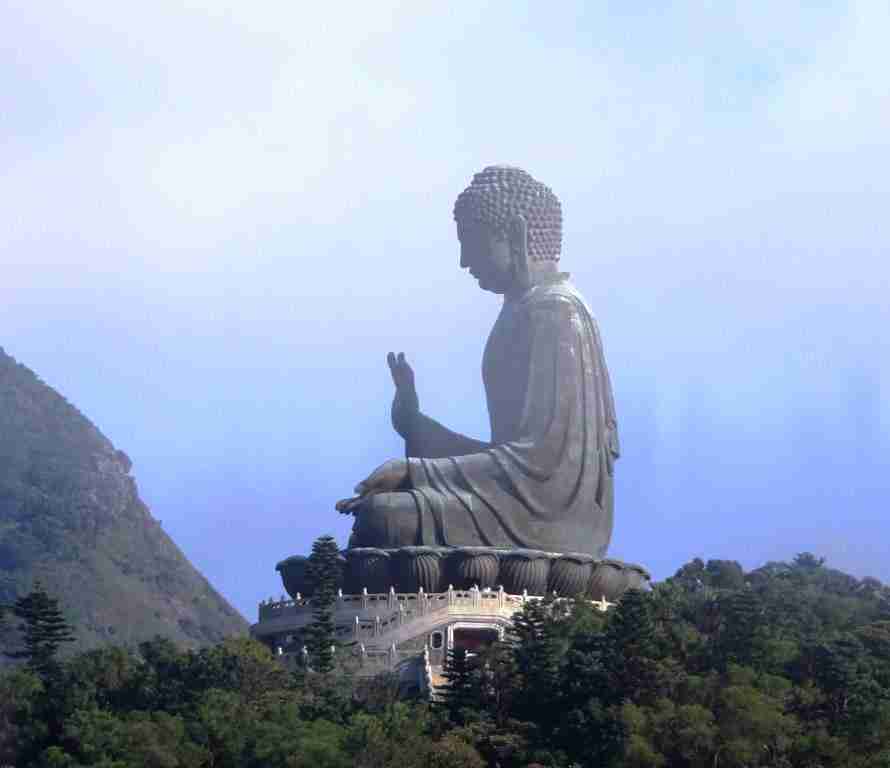
The Big Buddha
The Tian Tan Buddha or the Big Buddha is one of the most important landmarks of Hong Kong and draws visitors from around the world to the islands of Hong Kong. The huge, majestic Big Buddha statue stands 34 metres tall and is made from bronze. It sits at the top of Mount Muk Yue Shan beside the Po Lin Monastery and the Ngong Ping village on Lantau Island.
Throughout Asia, you’ll see many statues of the Buddha that represent the ancient Buddhist teachings and Hong Kong’s Big Buddha is one of the largest outdoor Buddhas in the world. Visiting the impressive Big Buddha is a great way to soak in Hong Kong’s history and culture and it’s one of the most popular historical attractions in Hong Kong.
How to get to the Big Buddha
The best way to get to the Big Buddha is to take Ngong Ping 360 cable car from Tung Chung MTR station on Lantau Island. The scenic cable car ride has breathtaking mountain and sea views and it takes around 30 minutes to reach Ngong Ping Village. From there it’s a short walk to the Big Buddha and the Po Lin Monastery.
TIP: I waited for over an hour to buy my ticket but you can skip the queues and buy your Ngong Ping 360 cable car ticket in advance.
Alternatively, you can catch a bus to Ngong Ping village. It’s much cheaper than the cable car. From Hong Kong Island take a ferry from Central Pier to Mui Wo on Lantau Island then bus no. 2 from the ferry pier.
Read Next: Visiting the stunning Big Buddha and the Po Lin Monastery.
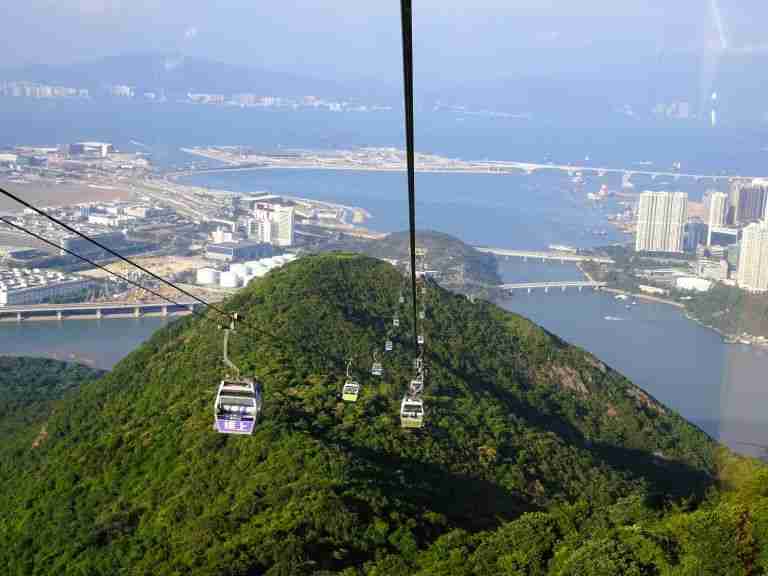
The Po Lin Monastery
Sitting beside the beautiful Big Buddha statue in Nong Ping village at the top of the mountain is the Po Lin Monastery. The monastery was founded in 1906 by 3 Zen Buddhist monks visiting from Jiangsu Province in China. The monks loved the beautiful, tranquil scenery of Lantau Island and the Po Lin Monastery and the famous Big Buddha are now one of the top historical attractions in Hong Kong.
The Monastery has an attractive shaded courtyard with seating and it makes a lovely retreat from the heat. As I wandered through the monastery, a Buddhist ceremony was in progress with monks chanting and praying. the main temples at the Po Lin Monastery have several sacred statues of the Buddha representing his past, present and future. The temples are beautifully decorated with colourful tiles and visiting is a lovely way to learn about Hong Kong’s history, religion and culture.
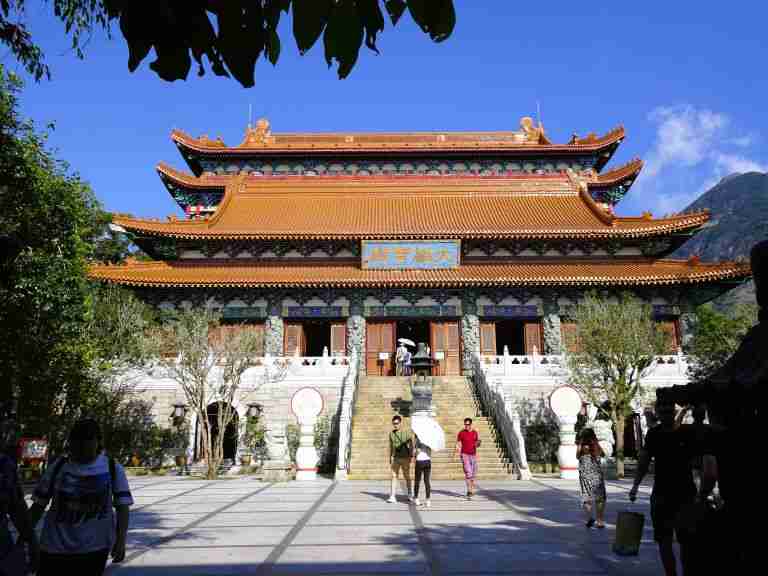
Islands & Fishing Villages
Visiting the islands in Hong Kong is a great day trip and a lovely way to enjoy the relaxed way of life in the fishing village and soak in the history of Hong Kong. In the beginning, the islands of Hong Kong were sparsely populated with small fishing villages. Today tourism has become more important as a source of income but fishing fleets are still operating. Seafood is a speciality and it’s fresh and delicious. You’ll experience this first-hand if you visit the villages on Cheung Chau, Lamma or Lantau Islands.
To get to the islands you’ll travel by boat as people have for centuries. You can learn about Hong Kong’s history and enjoy the fun of a ferry ride. When you arrive at Cheung Chau Island, you’ll find a harbour full of colourful fishing vessels. It’s worth the trip just to see the colourful harbour but there are lovely sea views, forested walking trails and pretty beaches to enjoy as well.
Village life continues on Cheung Chau and Lamma islands as it has done for centuries. There are no cars and people walk or ride bicycles to get around. If you stop and listen you’ll notice there’s no traffic noise. The ever-present hum of the city has disappeared, replaced by the lapping of water and the singing of birds.
To explore the islands simply follow the pathways on foot or hire a bicycle. All the islands have seafood restaurants on the waterfront near the ferry Pier and you can relax by the harbour and enjoy a meal. Spend a day visiting each of the islands and you’ll see a slower, more traditional way of life, a living history in Hong Kong.
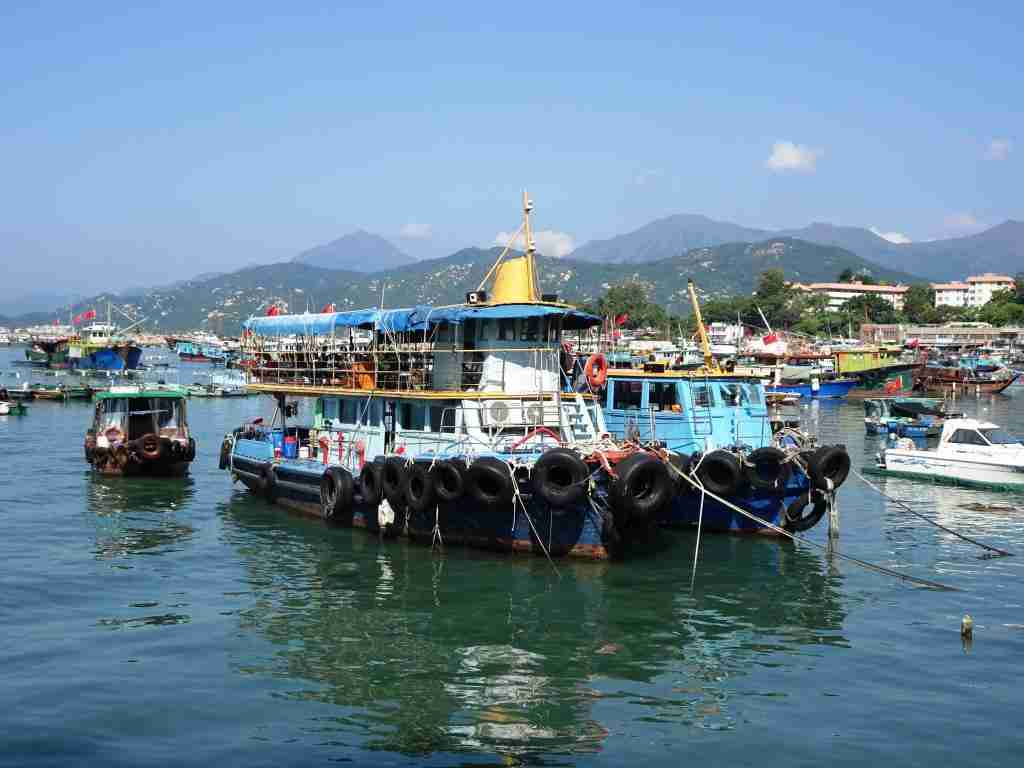
Smuggler’s Caves
On Cheung Chau Island you can visit the legendary smuggler’s cave and see where the Chinese Pirate, Cheung Po Tsai, hid his treasure. And there’s some Second World War History in Hong Kong to discover on Lamma Island. Follow the path across the island to find the cave that hid Japanese Kamikaze speedboats during WW11.
How to get there
Ferries to Cheung Chau, Lamma and Lantau islands leave from Hong Kong Central Pier.
The Aberdeen Fish Market
Another fun way to experience living history in Hong Kong is at the Aberdeen fish markets. Of the attractions in Hong Kong, the markets are a bit off the beaten tourist path but they’re fun to visit and you’ll get a feel for the history of Hong Kong and its seafaring origins. The Aberdeen Fish Market has been operating since the 1800s and you can learn about Hong Kong’s history by shopping with the locals.
Queue at the fresh fish stalls by the waterside on the promenade at Aberdeen Harbour and watch the fishermen selling their catch straight from their brightly coloured boats. It’s a fun way to start the day and the fish are as fresh as you can buy. But make sure you get there early.
The markets are open from 4 am.
TIP: If you’re looking for somewhere great to eat try the Aberdeen Wholesale Fish Market. Book in advance and arrive early. It’s open from 5:00 am – 2 pm.
How to get there
It takes about half an hour to get to Aberdeen on the other side of Hong Kong Island you can catch a local bus to get there.
TIP: The Hong Kong Hop-on-Hop-Off Green Route Sightseeing Tour will take you across to Aberdeen and to all the main sites on Hong Kong Island.

Do I need a Visa for Hong Kong?
People from most nationalities can visit Hong Kong without a visa for up to 14 days but will probably need a visa to visit mainland China.
Where to stay in Hong Kong
Budget: YHA Mei Ho Hong Kong
Mid-Range: The Salisbury YMCA of Hong Kong near the Star Ferry pier in Tsim Sha Tsui
Luxury: The Mandarin Oriental Hotel has a fabulous location in Central Hong Kong
The Peninsula Hotel in Tsim Sha Tsui is a luxury heritage hotel in a great location.
Accommodation in Hong Kong is expensive and Airbnb can also be a good option.
TIP: Book a transfer from Hong Kong Airport to your hotel and take the stress out of your arrival.
Final Thoughts
There are many historical places to visit in Hong Kong and lots of fun things to do to enjoy the rich history of the islands. I had a lot of fun experiencing first-hand the historical attractions in Hong Kong and I think that there’s no better education than experiencing the place, meeting the people, and visiting their sacred places. I enjoyed Hong Kong’s colonial history and was fascinated by the colourful and ancient Chinese traditions and the many historical landmarks of Hong Kong.
Know where you are and where you’re going. Take a trusted Travel Guide for China. I rarely travel without a Lonely Planet Guide.
For peace of mind make sure you buy travel insurance before you go, especially if you are travelling solo. I use and recommend travel insurance that covers overseas medical, evacuation, baggage and a range of other activities. With a good insurance policy, I can concentrate on enjoying my trip without worrying about something going wrong.
Pin it! Save this post for later!


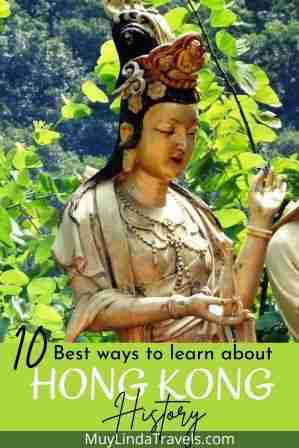

Travel Tips for China
The Big Buddha in Hong Kong – A Stunning Day Trip
The Ten Thousand Buddhas Monastery – A Hidden Gem

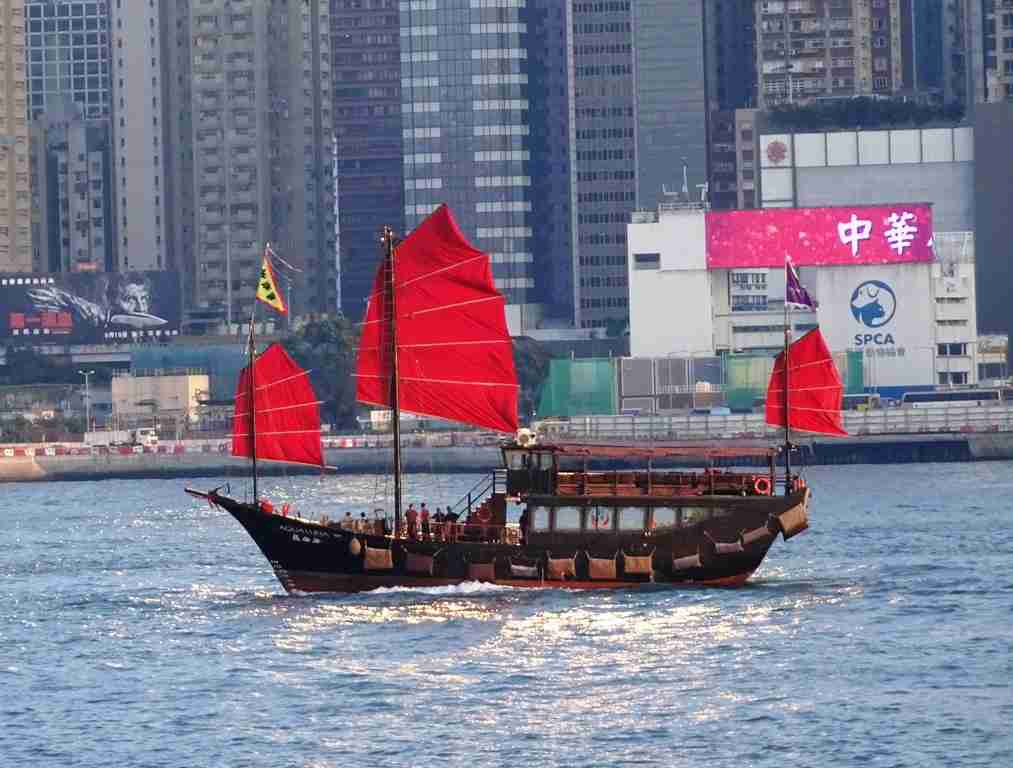
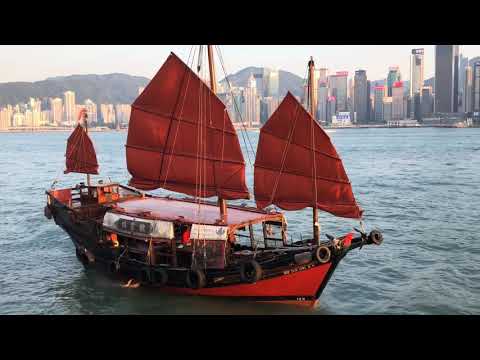



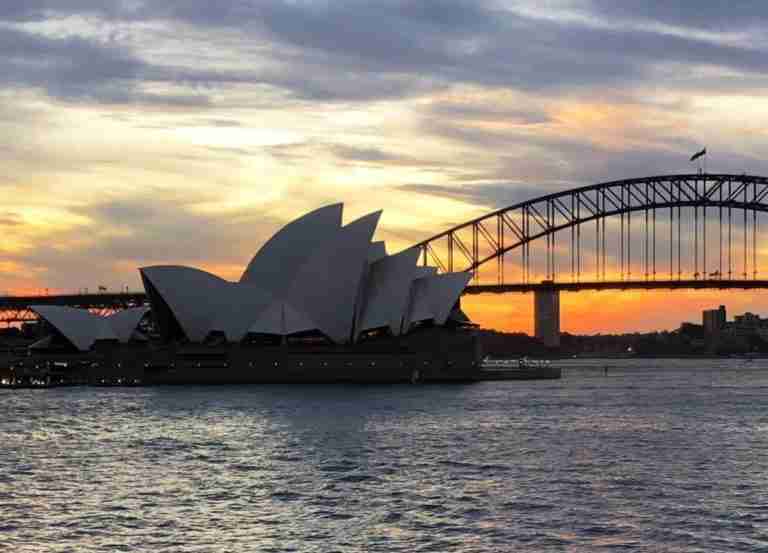

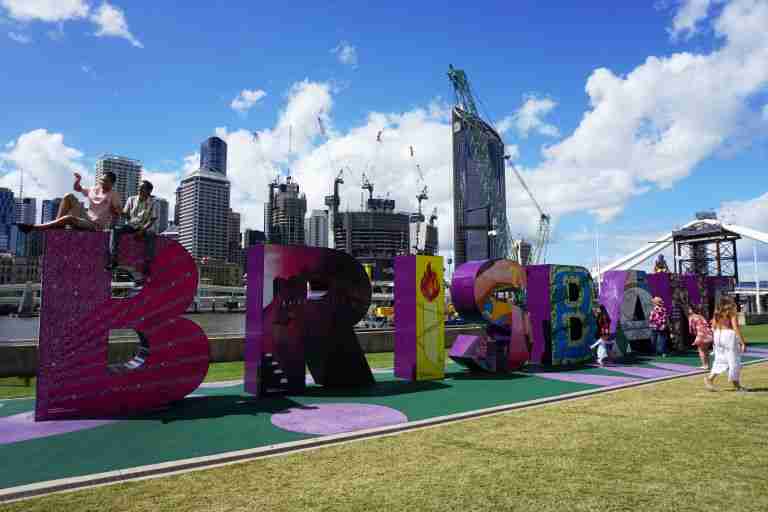
The Man Mo temples look so nice. I have been to a Chinese temple in Malaysia, and I loved how lovely it is to visit temples in a foreign destination. These places of worship are such a gateway to the culture of a country.
Wow I visited Hongkong but never explored these Lovely places ..saving it for later
I enjoyed my time in Hong Kong. What I remember the most is the Harlem Globe Trotters coming down the escalator in my hotel as I was going up! Plus I loved the Star Ferry and the Peak Tram.
This looks amazing. I love big buddhas and am quite in awe of them. This seems like a fascinating place to visit.
Great post. Hong Kong looks like an interesting place to visit and so rich in cultural and historic elements.
I lived in China for 2 years but somehow never made it to Hong Kong which is a shame. I’ll have to get there one day as it seems like it had quite the history and these places all sound really good. The Man Mo temple looks so beautiful, and I like the sound of visiting the smugglers caves
I always enjoy learning about a place’s history when I travel, so these tips will be really useful in the future when I get to Hong Kong!
These are all such fun ways to learn about Hong Kong’s history! I would love to take the Hong Kong Trams or the ferry! Those sound so fun and interesting. Now I need to visit Hong Kong!
I really love that you added some of the fascinating history of Hong Kong along with all of these beautiful places to explore. Thank you!
I have always wanted to visit Hong Kong. This is a fantastic resource. Thank you for putting it together.
I really loved this post. Hong Kong has always been a mistero to me and I was not sure if to add it to my Travel list, but I will definitely do it after reading this!
Thank you!
I love learning about the history of pplaces before and during my visit! I think it is really important to understand a place and what has shaped it when you visit! The Hong Kong Museum of History sound like a great place to start! The ferry and the temple also sound like fascinating highlights! Thanks for the great guide!
Great guide. Over the years when I’ve visited Hong Kong I have always taken the Star Ferry, it’s like a tradition each time. But riding the trams is also fun & a visit up to the Peak should be obligatory! Loads more ideas here for the next time I am there. I’ve never made it to the Big Buddha & many of the other places she mentions. Thanks for sharing!
I’ve always wanted to travel to Hong Kong. These are great tips and facts which will be very helpful when visiting. Thanks for sharing!
Great post on Hong Kong, I would love to visit its diverse landscape and cultural melting pot.
I have been to Hong Kong once on a layover between the Maldives and India. I would love to go back and spend more time exploring the highlights you posted above. Some are new to me so I plan to save your post for the future!
This was such an interesting read! I would love to visit Hong Kong someday – it’s definitely on my bucket list!